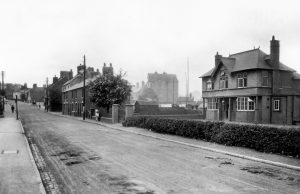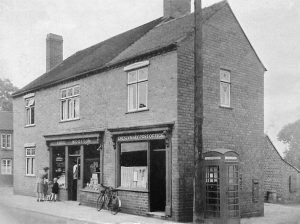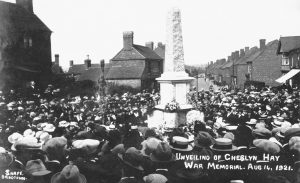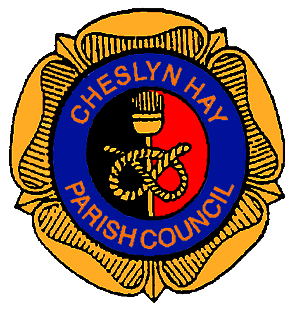Centuries ago Cheslyn Hay was referred to as Chistlyn, Chistlin, Chilsling and Chestle Haye. ‘Chist’ is an old English word derived from the Anglo-Saxon ‘cest’ meaning a chest or a coffin. A latter document dated 1790 refers to Chestlandhay and it seems evident that Cheslyn Hay derived its name from being the druidical site of the stone chest or coffin forming a pre-historic burial chamber.

With the roman Watling Street running close to the boundary of Cheslyn Hay there is enough evidence to suggest that during the construction of this road the Britons, spurred on by the Druids, arrested the Romans in their progress and there is no doubt that many skirmishes and encounters took place in the vicinity of Middle Hill.
No vestige or positive proof exists today to mark the site of the old burial place and the only clue to be found is in a deed of the year 1298 which informs us that William Trumwyn of Cannock gave to Robert le Champion of Saredon certain detailed properties of waste and woodland that lay between Saredon and Cheslyn Hay, which includes the drumlin (a rounded and artificial mound) and the semetre (cemetery). This description has led historians to believe that this site refers to Middle Hill.
‘Lyn’ is derived from the old English word ‘Hlinc’ meaning a hill and the appellation ‘Hay’ has Anglo Saxon origins from the word ‘hege’ relating to an enclosed place. Later, ‘Hay’ was purported to be a known locality be defined bounds, but not enclosed, and by the seventeenth century it meant being a place free from ecclesiastical and civil jurisdiction. In the reign of King Henry VIII, Leyland, the topographer, called Cank Forest (Cannock Chase) the ‘Forest of the Seven Hays’. Thus the old name of Chistlyn denotes the place of the ‘little chest or coffin’, or ‘the hill of the burial place’.

In the early 1800’s coal mining became the chief industry of Cheslyn Hay and it proved to be the beginning of our local community. Coal had been mined for many centuries on the Chase and in 1566 coal was dug in ‘a close’ called Cole Pit Field as is proved by a deed of that date. The field covered about seven acres and was situated at the top of what is now New Horse Road on the boundary of Cheslyn Hay and Great Wyrley and has passed into a great many hands since William Allport died in 1567.
The coal from early pits was conveyed by tramway from the coal wharf on Mount Pleasant for distribution to the edge tool works in Churchbridge and other sites. Coals had to be carried by horse drawn carts from the Coal Pit Fields down the New Horse Road to be checked on the weighbridge on Chapel Square.
With the arrival of the miners, edgetool workers and people of kindred industries came Methodism. In 1778 a Methodist Society was formed and a barn with a thatched roof situated in front of the present Sunday School, known as ‘Gasser’s Barn’ was their first meeting place.
This sufficed until 1806 when it was pulled down and replaced with the ‘Old Chapel’ situated in front of the present Sunday School, but in the following decades it became obvious that a larger and more prestigious building was required and so the Salem Church was built in 1854.

The ‘Old Chapel’ was finally demolished in 1889 and was replaced by the Sunday School, which, for the first time, provided facilities for the education of the poor children in the area. In 1824, the New British Schoolroom was built at what was known as ‘Woods Lot’ in Station Street but the teaching was not free and cost seventy shillings per annum. However, after the passing of the Education Bill, a Board School was opened in Pinfold Lane in 1882 to accommodate 250 scholars and this school was to last for over a century, finally closing its doors on the 19th July 1985.
As a mining village, Cheslyn Hay has always lived amongst death and tragedy but the devastation of the last century was that of the First World War when over 300 young men joined the Army to fight for King and Country. It has been said that this figure was the highest, percentage wise, throughout the country, so it is no surprise to see 57 names inscribed on the War Memorial at the centre of the Village, only for another 15 to be added after the 1939-1949 conflict.
